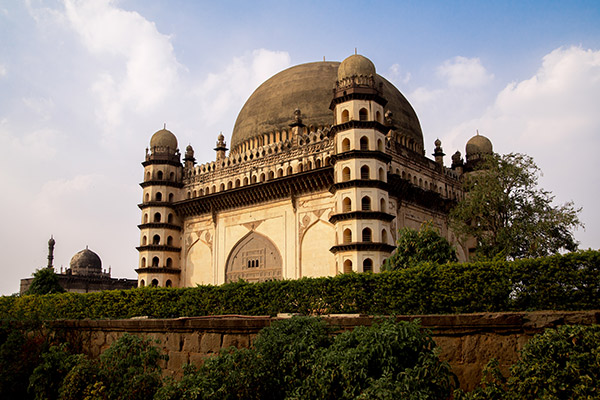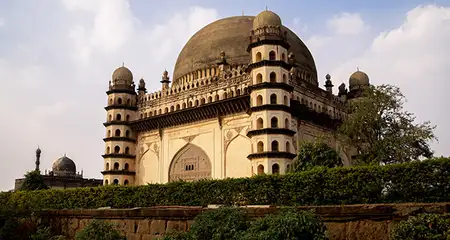Gol Gumbaz is an imposing mausoleum that displays the architectural brilliance of the bygone eras. Located in Bijapur aka Vijayapura, a small town in Northern Karnataka, this splendid structure has one of the biggest domes in the world. With a history of more than 350 years, it stands as one of the most famous mausoleums in India. If you are planning a trip to Karnataka, make sure to keep aside some time to explore this grand structure.
Looking for more details about this architectural wonder? This blog has everything you should know about Gol Gumbaz, including its history, architecture, timings, entry fee, and other interesting facts.
You May Also Like: Kannada Rajyotsava 2023 Date
Gol Gumbaz Information:
| Location | Bijapur or Vijayapura |
| Timings | 10:00 am to 5:00 pm; closed on Fridays |
| Entry Fee | ₹ 25 for Indians and SAARC citizens; ₹ 300 for foreigners |
| Timings of the Museum | 10:00 am to 5:00 pm; closed on Fridays |
| Museum Entry Fee | ₹ 5 per head |
| Camera | ₹ 25 |
| Date of Establishment | 1626 to 1656 |
| Commissioned by | Mohammed Adil Shah |
| Architectural Style | Deccan Indo-Islamic |
| Architect | Yaqut of Dabul |
| Status | Monument maintained by the Archeological Survey of India |
| Material Used | Dark grey basalt |
| Distance from Major Cities | Bangalore (525 km); Mysore (610 km); Goa (310 km); Pune (350 km); Mumbai (420 km); Hyderabad (380 km) |
Gol Gumbaz: History
This grand mausoleum is the final resting place of Mohammed Adil Shah, who was the ruler of Bijapur during the 17th century. The construction of the structure dates back to 1626 when the Sultan had just ascended the throne. It was his idea to build an impressive mausoleum for himself. Ironically, the structure was completed in 1656 after he breathed his last.
The name Gol Gumbaz has been derived from the words Gol Gumbadh or Gol Gummata, which means a dome in the circular shape. Since the most prominent feature of the structure is its giant circular dome, it came to be known as such. Apart from the Sultan’s mortal remains, the mausoleum houses the crypts of his two wives namely Taj Jahan Begum, Aroos Bibi, grandson, daughter, and his mistress Rambha.
Gol Gumbaz Architecture
Gol Gumbaz counts among the finest examples of Deccan Indo-Islamic architectural style. The colossal structure is made out of dark grey basalt. It reaches up to 51 meters in height while the giant dome has an external diameter of 44 meters, making it one of the largest domes ever built. Four dome-capped towers adorn the edifice on four sides. Each of these towers is seven stories high and has a staircase built inside it. A square podium with an intricately carved wooden canopy exists inside the main mausoleum hall. The cenotaph slab in the middle of the podium marks the location of the actual tomb of the Sultan, in the ground below.
The mausoleum hall boasts of an area 18000 sq. ft., which marks it as one of the world’s largest single-chamber spaces. An interesting feature of Gol Gumbaz is that a whispering gallery runs around the dome’s inner periphery. Any sound made here gets echoed at least seven times or more. When you are inside the whispering gallery, you can hear even the softest of sounds from the other side of the monument. This phenomenon is attributed to the impressive acoustics of the structure.
Another impressive aspect of this structure is that there are no towers or pillars that provide support to the huge dome, which is an architectural marvel in itself. The dome, on the other hand, is held by eight intersecting arches from the inside.
Gol Gumbaz: Today
Today, Gol Gumbaz stands as one of the most significant heritage monuments in India maintained by the Archeological Survey of India. It attracts a steady stream of visitors from far and near due to its spellbinding architecture and unique acoustic features. There is a museum situated near the structure that showcases an interesting collection of paintings, Chinese parchments, carpets, and other artifacts.
Things to See in the Gol Gumbaz Complex
Gol Gumbaz is located in a sprawling green compound that houses a few other attractions as well. These include the following:
- A mosque
- A Dharamshala or tavern
- Nakkar Khana or drum house
- A museum
- A well-maintained garden
Lesser Known Facts about Gol Gumbaz
- It is believed that the dome of Gol Gumbaz is the second largest in the whole world, the largest one being the dome of St. Peter’s Basilica in Rome.
- Mohammed Adil Shah built this huge structure during his reign because he wanted his tomb to be better than the tomb of his father, Ibrahim Rauza.
- This monument is sometimes referred to as the Taj Mahal of South India.
- When you enter the structure, you can see a stone hanging over its main entrance. Also called ‘bijli pathar’, it is in fact a piece of meteorite that fell onto the earth during the Sultan’s reign. It is believed that this stone protects the mausoleum from lightning.
- There is a train named after the structure – the Gol Gumbaz Express – that operates between Mysore and Solapur. The train passes via Bijapur.
Attractions near Gol Gumbaz
- Jamia Masjid (1.2 km)
- Gagan Mehal (2.1 km)
- Mehtar Mahal (2.4 km)
- Bara Kaman (2.3 km)
- Jod Gumbaz (2.7 km)
- Shri Siddeshwar Temple (2.7 km)
- Bijapur Fort (2.8 km)
- Malik-e-Maidan (3.1 km)
- Uplai Burj (3.3 km)
- Ibrahim Rauza Masjid (3.9 km)
- Saath Kabar (6.7 km)
Bijapur might not be one of the top tourist destinations in the country, but this small town has its own attractions in terms of architectural splendor and cultural heritage. Why not plan a trip to this town in Karnataka and enjoy a few days in the company of history and architecture?




























